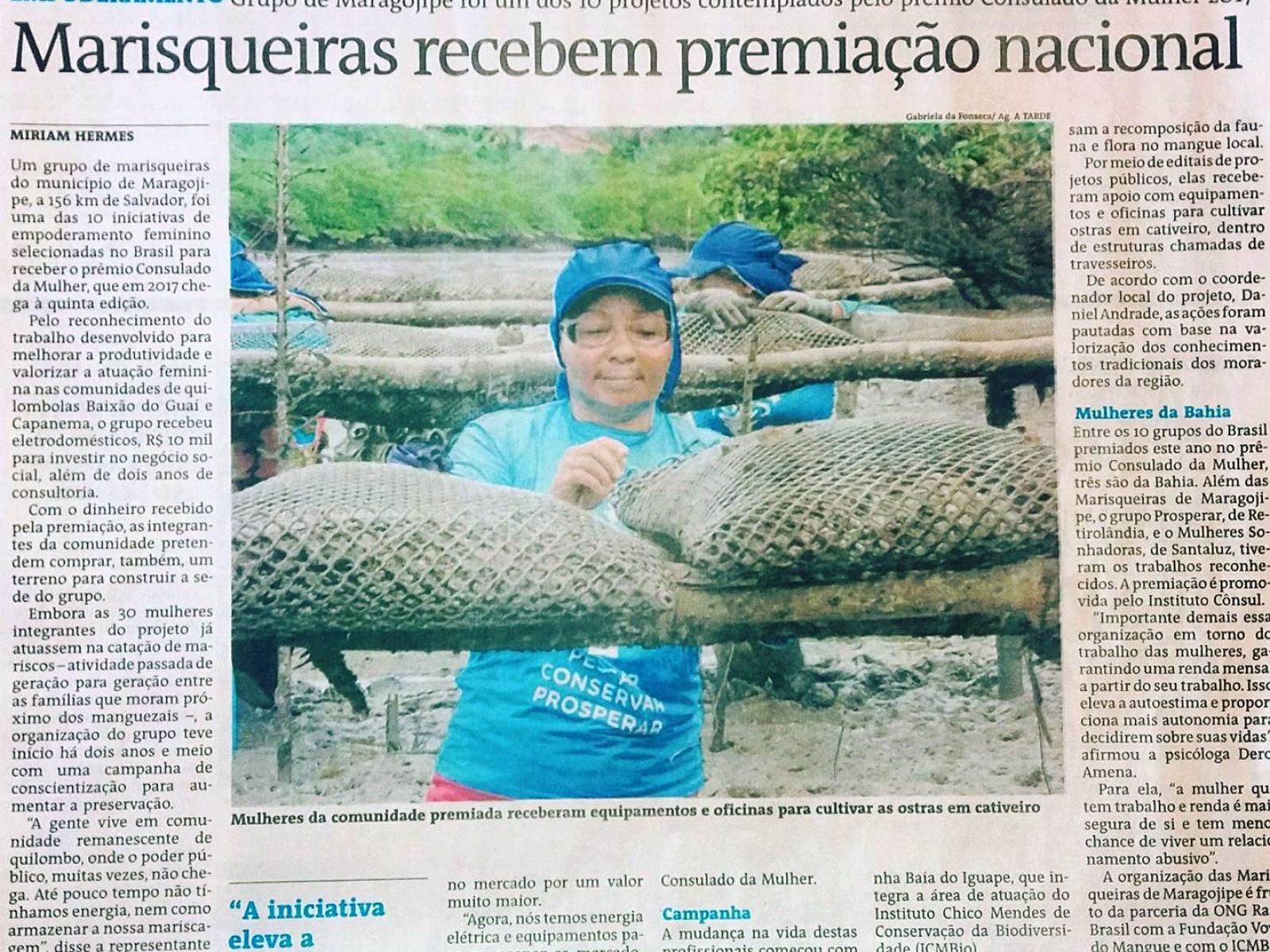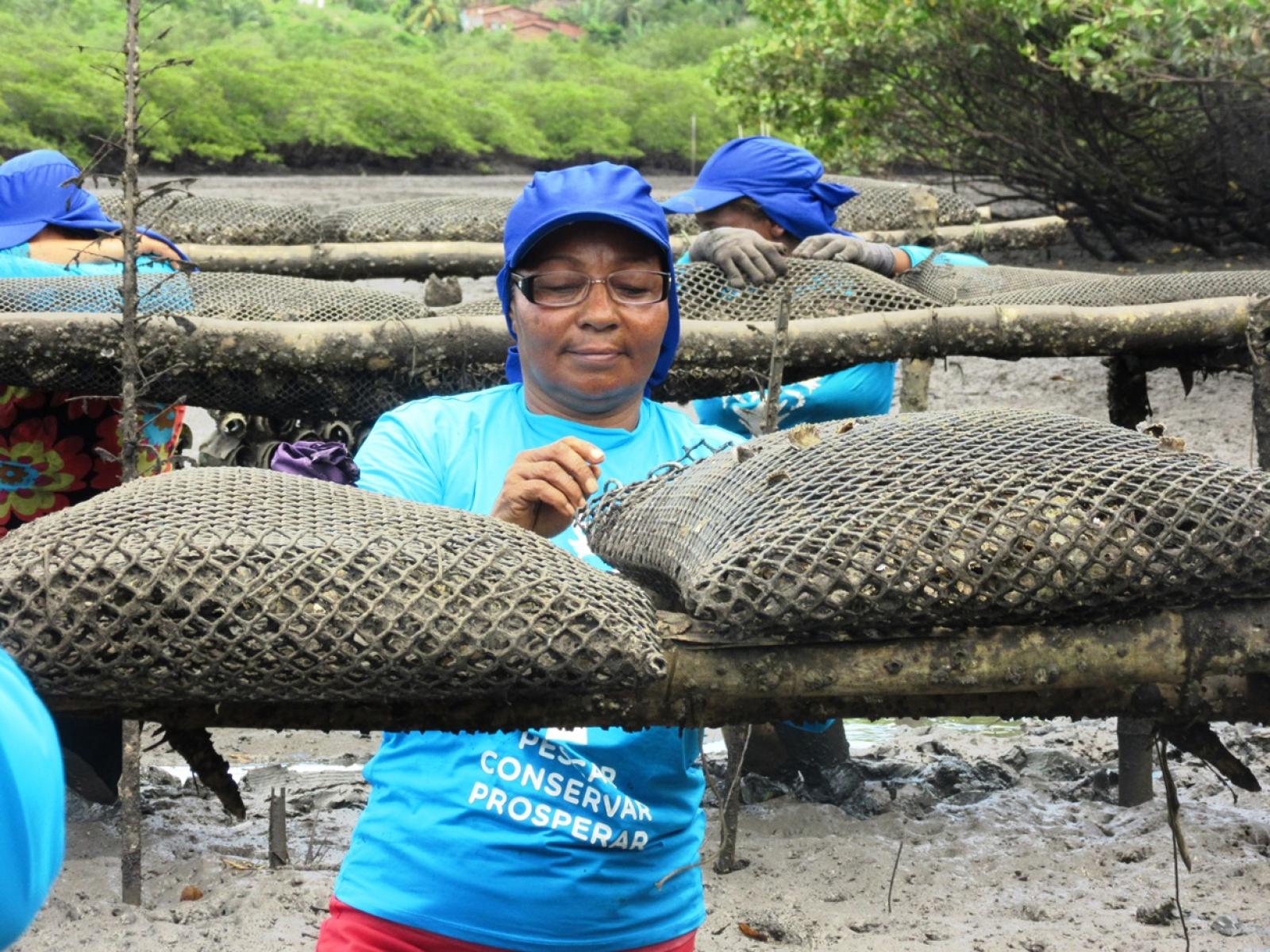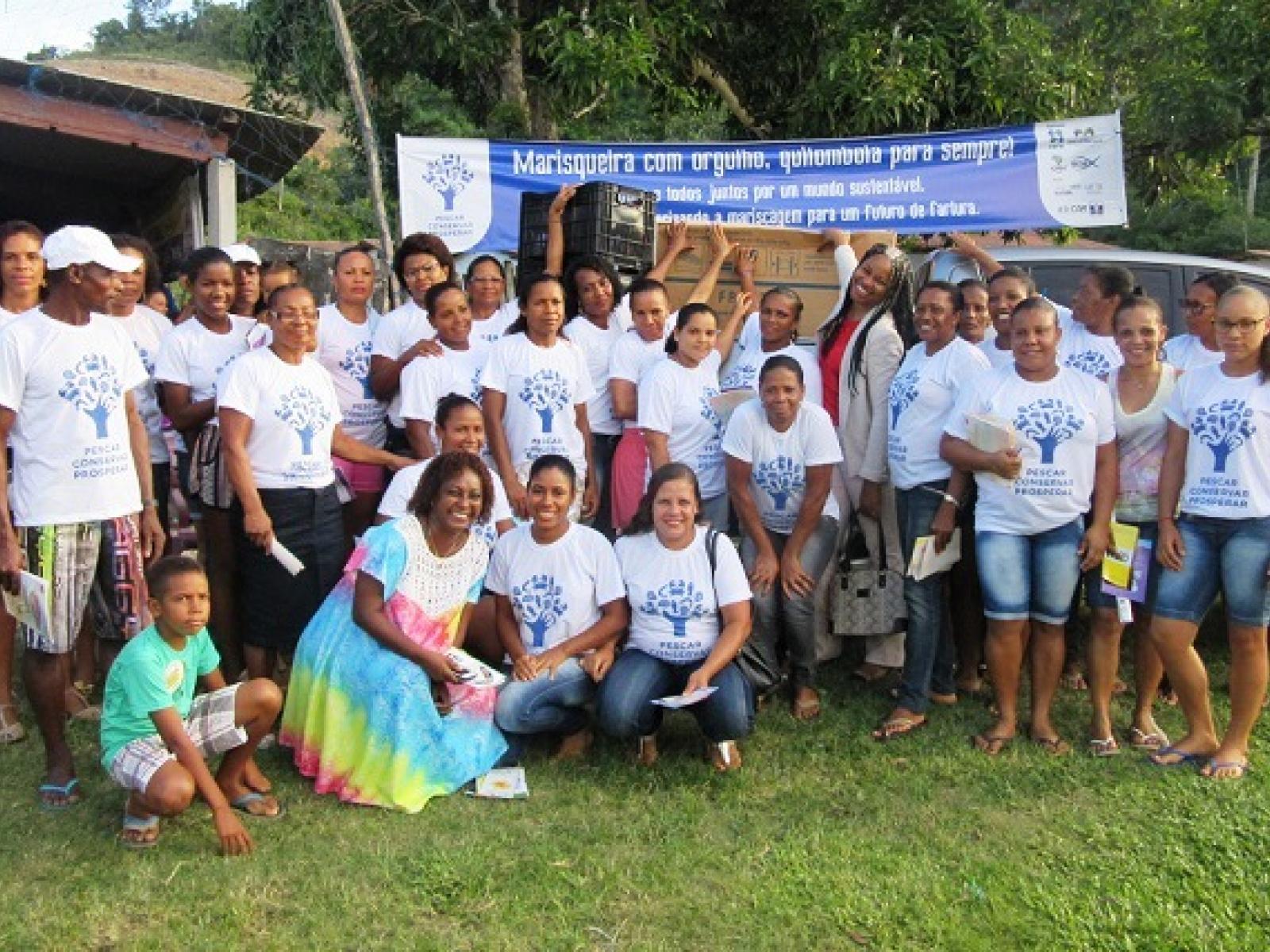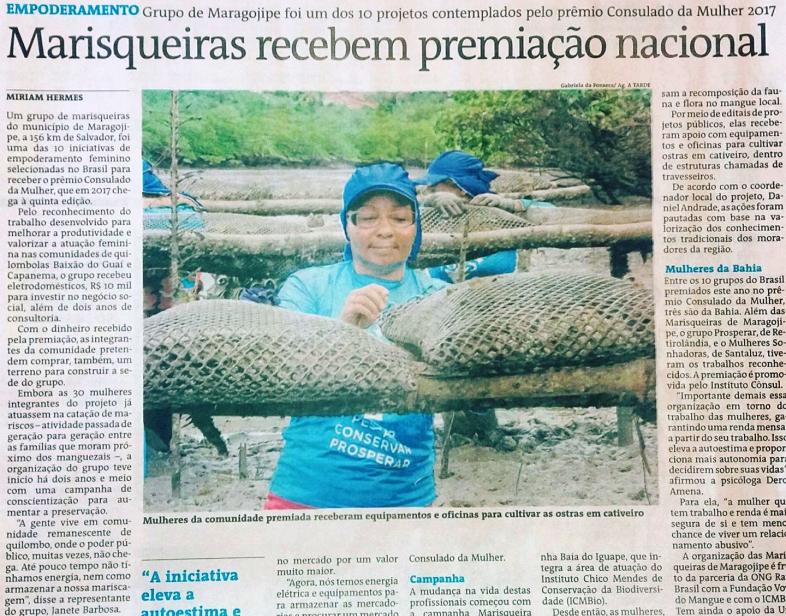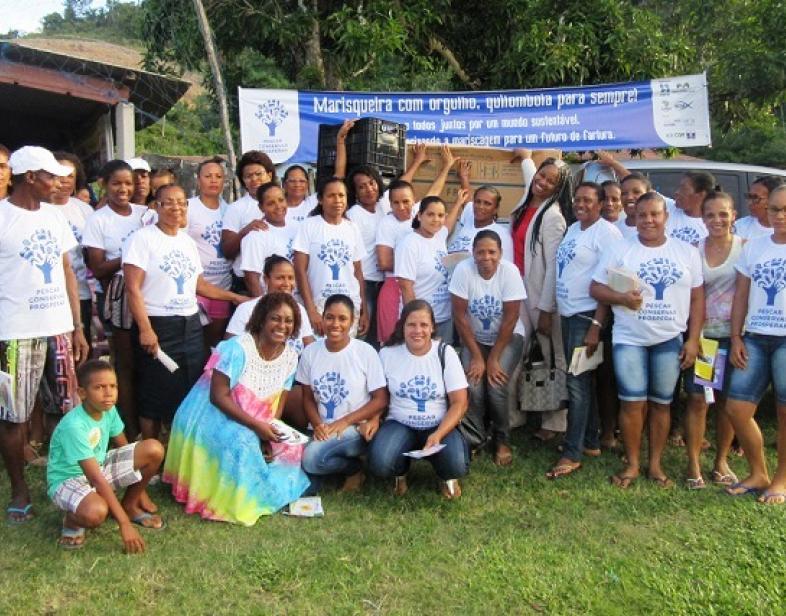An Overview Of Our Solution
The Mariquilombo project implemented a community oyster cultivation, the first in the region organized and managed only by quilombolas and extractivists women dedicated to artisanal collection of oysters and other shellfish in the communities of Capanema and Baixão do Guaí, located in Maragojipe, state of Bahia, within the Marine Extractive Reserve Iguape Bay. The project objects the productive inclusion and empowerment of these women, aiming at their social repositioning, improvement of life and access to the rights of citizenship, as well as the conservation of mangroves and the recovery of natural stocks of native oysters in free life, which has been falling in the last decade. The methodologies used in the development of the project were the theory of change, coupled with participatory management methodologies.
- Population Impacted: around 1,200 people
- Continent: South America
Last name
Organization type
Context Analysis
-Reduction of the female shellfish collectors territories of work by the impacts of human intervention: large enterprises (hydroelectric, Eucalyptus plantation, leather tannery, shipyard), environmental accidents, pollution and predatory extraction, resulting in the degradation of areas of mangroves and reduction of shellfish stocks, mainly oysters;
- Female shellfish collectors earning less than 80 dolars a month and selling their production at very low prices for the middlemen;
- Shellfish collectors disrespecting the management agreement of the extractive Reserve collecting oysters smaller than five centimeters;
- Devaluation and low self-esteem of female shellfish collectors, who suffered prejudice and did not feel proud of their work;
- Female shellfish collectors working individually, each responsible for collecting and selling their own seafood;
- Trash, mainly, plastic bottles in the mangroves.
Describe the technical solution you wanted the target audience to adopt
Community cultivation of oysters was the technical solution found. We used the same social technology existing in the quilombola communities of Kaonge and Dendê, in the municipality of Cachoeira, in which bamboo is used in the making of benches and plastic bottles in the manufacture of oyster seed collectors. The cultivation use low space and water, does not depend on the addition of nitrogen and phosphorous and shows potential to remove surplus nutrients in the aquatic environment and absorb greenhouse gases. Furthermore, it can collaborate with the recovery of natural stocks of oysters, since the cultivation of these molluscs reduces the effort of catching them in free life within the estuary of the Reserve. The innovation, in our case, lies in the fact that the cultivation implanted in Maragogipe is managed only by women. The methodology of implantation and management of the project was another differential.
Type of intervention
Describe your behavioral intervention
The behaviors I tried to change were: I hoped that female shellfish collectors adopt and believe in community oyster cultivation as a viable alternative to income generation, productive inclusion, and improved livelihood for them; that they could organize themselves and work together in the cultivation; that they stop collecting free-living oysters smaller than five centimeters; that they feel more valued and proud of being shellfish collectors; that they stop selling the kilo of oysters to sell the dozen, and managed to organize themselves to sell directly to restaurants; and, finally, I hoped that they conserve and take care of the mangroves, giving new use to the plastic bottles found there.The project has privileged the social and political qualification of these women, enabling alternatives and productive means, based on the local potentialities, traditions and experiences.
To guarantee the adoption of the desired behavior, we use the theory of change allied to participatory methodologies of project management. The theory of change was important in identifying the barriers that impeded behavior change and in formulating strategies to overcome them, but it was the participatory management of the project through the involvement of shellfish farmers in decision-making and the creation of affective and confidence links with the management team that has ensured its success.
As needed, please explain the type of intervention in more detail
- Respect local knowledge: rather than presenting themselves as knowledge holders capable of promoting local development, the staff have shown to these women that they are able to choose what is best for themselves.
- Follow-up with autonomy: many projects finish when technicians leave the group; the monitoring should be continuous until the group has conditions to walk alone, but the group can not be guarded to the point of being dependent.
- The project is theirs, not for them: show the project was not something given as a gift and it depends on their participation and make them protagonists of the whole process.
- Exchange: see the oyster cultivation closely and talk to other shellfish collectors to believe that it is possible.
Describe your implementation
To know the people and the community: as important as knowing the reality of the place is to know the people, where and how they live, their yearnings and dreams. Diagnosis can not only reflect data, numbers must have faces and names.
- We carry out technical follow-up and frequent meetings for collective decision-making on all aspects of the project.
- We held social and political training workshops, with monthly meetings for nine months, which we discuss topics as Solidary Economy, association, cooperativism, shared management, networking, fighting against violence against women, fighting racism.
- We had technical workshops for learning on how to implant the cultivation, from the construction of the benches, the handling of the baskets, the cleaning of the oysters.
- We held a day of exchange of knowledge with the communities of the Kaonge and Dendê, where the female shellfish collectors knew a close up cultivation of oysters in operation, cleared their doubts, talked with other shellfish collectors and quilombolas.
- We divided the women in groups and organized the scheme of surveillance of the cultivation, fundamental also so that they began to work together.
- We promoted oyster sales actions at events and participated in Solidarity Economy fairs so that shellfish producers could gain the confidence of dealing directly with customers.
- We involved two young daughters of shellfish collectors in the project as fellows of scientific initiation assisting the team of researchers of the UFRB in the collection of data.
- We developed a communication work to give visibility to the group that resulted in spontaneous media in newspapers and two prizes received, one at national and the other state level.
- We promote exchanges between traditional and scientific knowledge, bringing researchers and shellfish farmers to the field.
- We articulate institutions and partnerships that have believed and committed to the project and to the female shellfish collectors.
External connections
Assuming that the persistence of social and gender inequalities is incompatible with the construction of sustainable societies, the project has been pursuing public policies conquered by feminist movements, attracting different governmental and non-governmental institutions in the provision of joint services, according to their attributions and specialties. The Mariquilombo Project is a result of the Pride Campaign developed by Rare Brazil in Maragogipe. Rare Brasil is the funder of the campaign and biological monitoring; Chico Mendes for Biodiversity Conservation Institute (ICMBio), local technical and logistical support; Vovó do Mangue Foundation, logistic and administrative support; Secretariat of Policies for Women of Bahia (SPMBa), financed the cultivation in 41.600 reais and was the responsible for courses and workshops; Federal of Recôncavo of Bahia University (UFRB), responsible for monitoring the environment and the target specie, in this case, the oyster; Bahia Fishing, technical support; Regional Development and Action Company (CAR), also a funder of the cultive; and Consulate of the Woman, financing of 10.000 reais, donation of appliances (freezers, stoves and water purifiers) and consulting for two years. The University continues to produce important data for the reserve management and development of the cultivation, and the Women's Policy Secretariat has transformed the work with female shellfish collectors into one of the institution's flagships.
Who adopted the desired behaviors and to what degree?
Of the 30 female shellfish collectors who participated from the beginning, only 8 gave up and 22 adopted the desired behaviors. The oyster farming is in full operation, counting on 80 baskets and more than 60.000 oysters. Women are responsible for all stages of production. They were used to sell one kilo of oysters (equivalent of 9 dozen) for R$ 18. Now they sell one dozen oysters for R$ 25. The expectation is that it will increase the income of these women by at least 30% soon. They stopped marketing oysters smaller than 5 centimeters. Now they put them in the cultivation and wait for them to grow. They are more aware about conserving mangroves and are using plastic bottles to produce the oyster seed collectors. They are more proud of their work and with higher self-esteem. The project also increased the visibility given to these women who have already received two awards (Consulado da Mulher 2017 and Barra Mulher 2018).Today we have a list of women who want to be part of the project.
How did you impact natural resource use and greenhouse gas emissions?
We have not yet carried out studies to obtain this kind of impact, but a study carried out on the native oyster fattening system similar to ours at the Mandira Reserve in São Paulo concluded that the cultivation presents high environmental sustainability.It uses few natural resources, incorporates renewable energy into production and removes excess nutrients from the ecosystem.Producers recover 8 times more carbon, 7 times more nitrogen and 6 times more phosphorus than was applied in the cultivation (MIRALDO, Marcel, 2015).The study also noted that cultivation absorbed 2.63 tonnes of gas per tonne of oyster produced, much more than carbon sequestration of tilapia and shrimp crops. The methodology analyzed the release of pollutants through indicators measuring the nitrogen, phosphorus and organic matter released into the environment in liquid effluents and sediment, and the greenhouse gases in carbon dioxide equivalents released into the atmosphere in relation to the unit of production.
What were some of the resulting co-benefits?
Related to the community/social field, the development in the organizational capacity of female shellfish collectors who now work in a collective way and have already created a legally formalized association. They are more participative within the community, more knowledgeable about their rights and duties, more empowered to be alert to situations of violence and more proud to be shellfish collectors. In the category of biodiversity conservation, there is growing awareness of the importance of conserving mangroves and respecting the management agreement of Reserve. They do not market oysters smaller than 5 centimeters and recycle plastic bottles. In the economic/sustainable development category, the initiative has generated productive inclusion and extra income for 22 families of female shellfish farmers, directly benefiting more than 100 people and, indirectly, more than 300 families that also depend on mangroves.
Sustainability
The initiative depended on public financing for its implementation, but once it is in operation, the enterprise is self-sustaining, because oysters are a valued product and there is demand in the local market.Despite the extensive coast in Bahia with waters that are suitable for the development of native oysters, the local market is supplied by oysters produced in Santa Catarina.There is local market for oysters, but there are still few oysters cultivations in Bahia. In addition, it is a sustainable undertaking because it is an activity based on cooperativism and the principles of Solidarity Economy, capable of producing and generating income for dozens of families, offering the consumer market a quality, competitive and fair price product.
Return on investment
The implantation of the oyster cultivation cost 41,600.00 reais. This amount was made available by the Poverty Fight Fund through Secretariat for Women's Policies and Regional Development Company. It is therefore a low-cost project compared to the results obtained. Currently the cultivation has more than 60,000 oysters, and the dozen are being sold at R$ 25.Therefore, in just over two years, the social enterprise already has a real possibility of return of 125,000.00 reais, that is, three times more than the amount invested. And we are not yet talking about the environmental and social return, as a result of the decrease in the effort to catch oysters in free life, and the productive inclusion and empowerment of female shellfish collectors.
How could we successfully replicate this solution elsewhere?
The project can easily be replicated benefiting more women extractivists and collaborating in the conservation. The cultivation of Mariquilombo is a reapplication of the social technology of the cultivation of native oysters, adapted by a methodology focused on productive feminine inclusion, having the support and the partnership of institutions that acted together. In Bahia, this is the only initiative of the type directed exclusively to women, although they are the main responsible for collecting shellfish in the state. For the implantation of the cultivation and purchase of equipment only 41,600 reais were spent. Spending on staff can depending on the partners involved. In our case, the training workshops were carried out by the Secretariat of Policies for Women, so the main expenditure with staff was the payment of the coordination. The main interested partners who continue collaborating are the Secretariat of Policies for Women and the Federal University of the Recôncavo.
